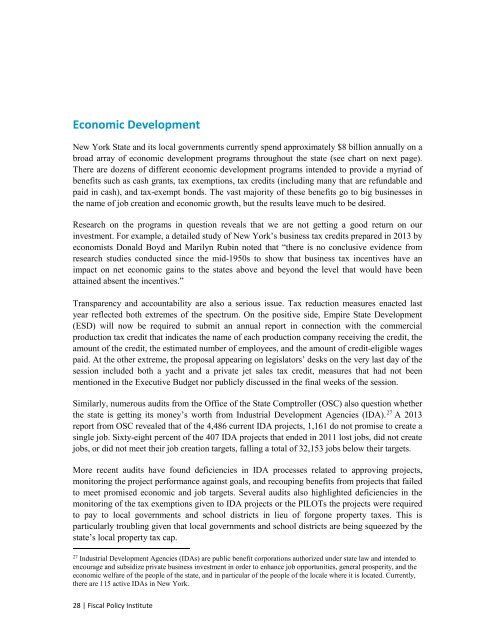2016-2017
1PSJ98W
1PSJ98W
You also want an ePaper? Increase the reach of your titles
YUMPU automatically turns print PDFs into web optimized ePapers that Google loves.
Economic Development<br />
New York State and its local governments currently spend approximately $8 billion annually on a<br />
broad array of economic development programs throughout the state (see chart on next page).<br />
There are dozens of different economic development programs intended to provide a myriad of<br />
benefits such as cash grants, tax exemptions, tax credits (including many that are refundable and<br />
paid in cash), and tax-exempt bonds. The vast majority of these benefits go to big businesses in<br />
the name of job creation and economic growth, but the results leave much to be desired.<br />
Research on the programs in question reveals that we are not getting a good return on our<br />
investment. For example, a detailed study of New York’s business tax credits prepared in 2013 by<br />
economists Donald Boyd and Marilyn Rubin noted that “there is no conclusive evidence from<br />
research studies conducted since the mid-1950s to show that business tax incentives have an<br />
impact on net economic gains to the states above and beyond the level that would have been<br />
attained absent the incentives.”<br />
Transparency and accountability are also a serious issue. Tax reduction measures enacted last<br />
year reflected both extremes of the spectrum. On the positive side, Empire State Development<br />
(ESD) will now be required to submit an annual report in connection with the commercial<br />
production tax credit that indicates the name of each production company receiving the credit, the<br />
amount of the credit, the estimated number of employees, and the amount of credit-eligible wages<br />
paid. At the other extreme, the proposal appearing on legislators’ desks on the very last day of the<br />
session included both a yacht and a private jet sales tax credit, measures that had not been<br />
mentioned in the Executive Budget nor publicly discussed in the final weeks of the session.<br />
Similarly, numerous audits from the Office of the State Comptroller (OSC) also question whether<br />
the state is getting its money’s worth from Industrial Development Agencies (IDA). 27 A 2013<br />
report from OSC revealed that of the 4,486 current IDA projects, 1,161 do not promise to create a<br />
single job. Sixty-eight percent of the 407 IDA projects that ended in 2011 lost jobs, did not create<br />
jobs, or did not meet their job creation targets, falling a total of 32,153 jobs below their targets.<br />
More recent audits have found deficiencies in IDA processes related to approving projects,<br />
monitoring the project performance against goals, and recouping benefits from projects that failed<br />
to meet promised economic and job targets. Several audits also highlighted deficiencies in the<br />
monitoring of the tax exemptions given to IDA projects or the PILOTs the projects were required<br />
to pay to local governments and school districts in lieu of forgone property taxes. This is<br />
particularly troubling given that local governments and school districts are being squeezed by the<br />
state’s local property tax cap.<br />
27<br />
Industrial Development Agencies (IDAs) are public benefit corporations authorized under state law and intended to<br />
encourage and subsidize private business investment in order to enhance job opportunities, general prosperity, and the<br />
economic welfare of the people of the state, and in particular of the people of the locale where it is located. Currently,<br />
there are 115 active IDAs in New York.<br />
28 | Fiscal Policy Institute


